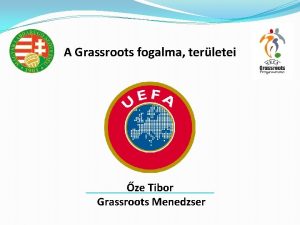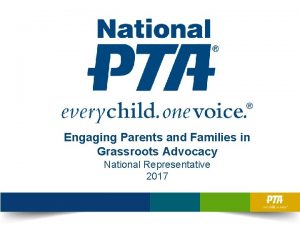Understanding Grassroots Advocacy Parents can make a difference



















- Slides: 19


Understanding Grassroots Advocacy

Parents can make a difference for their child and every child.

PTA’s Advocacy History Because of PTA, our nation has. . . § Kindergarten as a part of our public school system § Child labor laws to protect against unsafe working practices and conditions § Federally funded hot-lunches that feed 26 million children today in our public schools § A separate juvenile justice system so children won't § § be tried and incarcerated as adults Labels on music recordings to help parents know which contain “explicit lyrics” TV ratings to help parents evaluate programs

What is Advocacy? The act of mobilizing individuals to spark changes in programs and policies at the local, state, and national levels

Steps to Effective PTA Advocacy 1. Research the issue 2. WHAT PTAs MAY AND MAY NOT DO AROUND ELECTIONS 3. Organize around goals 4. Build our volunteer network 5. Target our efforts for maximum effect 6. Develop an appealing message 7. Evaluate results

Step 1: Research the Issue The better informed we are, the better our strategy § What is the history of the issue? § Who has authority over issue? § Has the issue come up before?

WHAT PTAs MAY AND MAY NOT DO AROUND ELECTIONS PTAs are considered non-profit charitable organizations (501(c)(3)) under federal tax law. PTAs are encouraged to help educate voters about issues important to children, but with 501(c)(3) status they cannot engage in direct partisan political activity and are limited in the amount of lobbying they can do.

PTA Can Advocate ü Host a candidates’ forum ü Urge voters to support or oppose a particular ballot measure; ü Register voters and remind members to vote; ü Educate candidates on issues important to PTA; ü Engage in limited lobbying, including work on ballot measures; ü Conduct nonpartisan public education and training ü Canvass the public on issues.

PTA cannot Advocate Endorse candidates or a political party for public office. Invite only one candidate or political party in an election to come speak to the PTA. Ask candidates to sign pledges on any issue (tacit endorsement). Tell PTA members to only vote for a candidate who supports “X” position. Distribute any campaign materials on behalf of a candidate. Wear campaign buttons or t-shirts during a PTA meeting.

Step 2: Organize Around Goals should be specific and achievable, such as: § Placing an issue on the agenda of an upcoming school board meeting § Convincing the principal to improve the nutritional value of the school lunch program § Increasing the number of advanced placement courses offered at the school

Step 3: Build Our Network Start by talking about the issue § § Speak with parents about the importance of the issue Tell them how they can help Invite them to become involved Build a network of supporters

Step 4: Target Our Efforts Use our volunteers effectively, by wisely targeting our efforts § Rally supporters of the issue § Don’t focus on changing strong opponents § Focus on the undecided—help them understand why they should support the issue

Step 5: Develop an Appealing Message A persuasive message… § § Is short and to the point Easy to grasp and understand Gives three solid reasons for supporting the issue Gets a positive response from people

Step 6: Evaluate Results Evaluating our strategies and actions § § Provides a ‘check and balance’ on our efforts Allows us to be flexible—to change course if tactics aren’t getting desired results Helps us know what works well Lets us build on our efforts over time

Ways PTA Members Make Their Voices Heard § Meeting with principals to create a parent involvement plan for the school § Meeting with the district superintendent to express concerns about proposed changes in curriculum § Testifying before school boards about important district-wide policies § Supporting a local school levy by recruiting and organizing volunteers

Advocacy Is Fun! Advocating for change can be a long process. We promise to… § Report regularly on progress to help parents and volunteers see the small ‘wins’ along the way § Feed our volunteers—with enthusiasm, encouragement, feedback, and treats! § Celebrate our success!

Advocacy Resources To learn more about PTA’s advocacy efforts at the national level and how you can get involved, visit www. pta. org/issues_and_action. html To take an e-learning course on becoming an effective advocate, visit www. pta. org/leadership_training_resources. html To contact PTA’s Office of Programs and Public Policy, call: (800) 307 - 4 PTA (4782)

 Go make a difference we can make a difference
Go make a difference we can make a difference Frida kahlo peinture mes grands parents et moi
Frida kahlo peinture mes grands parents et moi Parents parents
Parents parents Fiche artiste frida kahlo
Fiche artiste frida kahlo Communication between parents and teenagers
Communication between parents and teenagers Tabas model
Tabas model Fifa grassroots football
Fifa grassroots football Arizona soccer club grassroots
Arizona soccer club grassroots Grassroots trust zambia
Grassroots trust zambia Taba's grassroots rational model strength and weakness
Taba's grassroots rational model strength and weakness Grassroots lobbying mass mobilization
Grassroots lobbying mass mobilization Grassroots growth
Grassroots growth Uefa grassroots
Uefa grassroots One person can make a difference essay
One person can make a difference essay How to get trust back from your parents
How to get trust back from your parents Can two blue eyed parents have a brown eyed child
Can two blue eyed parents have a brown eyed child Can 2 blue eyes parents have a brown eyed child
Can 2 blue eyes parents have a brown eyed child I believe i can deepen my understanding
I believe i can deepen my understanding Make the lie big keep it simple
Make the lie big keep it simple Make the lie big make it simple
Make the lie big make it simple



































